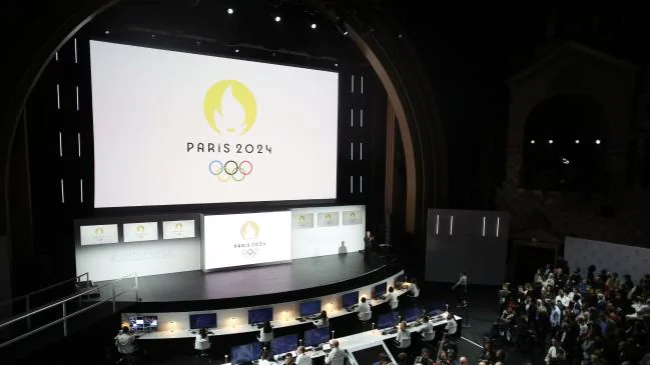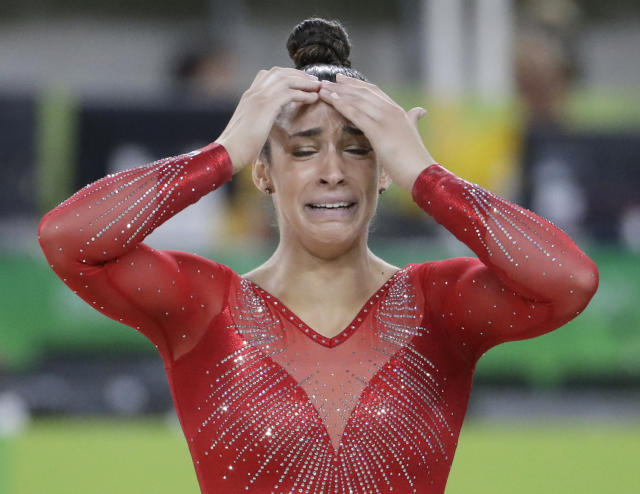
This article is more than
9 year oldAly Raisman, 'the underdog,' bit back
Medal count | Olympic schedule | Olympic news
RIO DE JANEIRO — Aly Raisman’s coach has a saying for his gymnast.
“We are the underdogs,” Mihai Brestyan tells her. “The underdogs, sometimes, bite harder.”
On Thursday, four years after losing the podium on a tiebreaker, the underdog bit back.
Raisman needed a superb floor routine to clinch a silver medal in the all-around final here, and boy did she deliver, starting with an initial tumbling pass that has gone viral on social media this week and finishing with tears ready to roll down her face. As she came to a final rest, she could see fans standing for her in a foreign country, her parents among them. She could see the normally stoic Brestyan hopping and cheering for her. She let the tears come. She couldn’t hold back. And for the first time in so long, she didn’t have to.
“This is something you dream in your wildest dreams,” she said.
If Simone Biles has been a study in the impossible, Aly Raisman has been a display of what’s possible. It is rare for a gymnast to return after four years, to go through the sadness of missing a medal, to go through the soul-searching of what’s next, to go through the re-training, and then to go through more years of elevating to a brand new level at age 22. Brestyan said that now-famous first pass on the floor routine took two years to conjure and implement, and it pushed Raisman past where she already stood as 2012 Olympic champion of the routine.
“I didn’t always think I was good enough,” Raisman said, “and that’s why I worked so hard.”

Hers is, above everything, a story of toil. It’s not to say that Biles and the others don’t work; to be an elite gymnast is to be a maniacal worker. But from the very beginning of her career, Raisman won her coaches’ hearts and her teammates’ allegiance with her effort.
“She was very excited to be the best,” Brestyan said. “The desire to work, it’s what I was looking for. I need this. The talent I can modify. Fears, I can change. But give me that discipline. Because if you don’t have that, I can’t work with you. She gave me that.”
Raisman only lost the bronze in 2012 because of a bizarre tiebreaker – she and 2016 bronze medalist Aliya Mustafina had equal scores, but Mustafina got the bronze based on gymnastics’ “count-back” system, a rule so cruel that the coach said Thursday she feels the rule should be changed and Raisman should have received a medal for a virtual tie with Mustafina.
“I think the federation, the IOC, they need to give it to them,” Brestyan said. “It’s the end of four years work … do not make that differentiation. You are the same. Give it. Because you did the same.”
Doing “the same” wasn’t enough for Raisman in 2012, and there was a strong chance she would have to live with that for the rest of her life. When she did decide to try it again, Brestyan was so skeptical that she made Raisman work for a year to prove she meant it.
“I know the road is very difficult,” she said. “I don’t want them to be back just for fame.”
As difficult as making the best team in the world was in 2012, it would be even tougher this time. By late in 2013, it was clear Biles was otherworldly. Gabby Douglas, if she chose to return, was the defending Olympic champion. Then there were younger gymnasts – far younger than Raisman in gymnast years. Laurie Hernandez, Madison Kocian, even Regan Smith, who was born in 2000.
“Hard times,” Brestyan said. “A lot of hard times.”
Much of the media coverage was about Biles and Douglas, and then, late this summer, it was about Hernandez. Raisman loved them all, but there was her coach saying it again: “We are the underdog.” This week was a trace of agony, as the time between the team gold medal and the all-around final seemed to crawl. “I just wish it was here,” Raisman kept thinking.
On Wednesday, as the video of her first floor pass ricocheted around the Internet, Raisman noticed a tweet of it with the caption: “I just don’t get how this is physically possible.”
She retweeted it with the message: “Years and years of conditioning and millions of repetition. Didn’t happen overnight. Started training this pass at 14.”
Raisman needed eight years for this moment, and she made that moment count. Her five total medals are second-most ever for an American female gymnast, tied with Nastia Liukin and Mary Lou Retton.
After Biles and Raisman left the podium, outgoing coach Marta Karolyi was asked what defined the American gymnastics style she had built.
“It’s power, hard work and the aggressiveness and preciseness,” she said. “Consistency is our trademark.”
Those exact same words can be used to describe Raisman. She is the model for gymnasts to come, in how she worked, how she performed and, as a two-time captain, how she led.
Raisman lived her dream on Thursday, finally. But her contribution to American gymnastics is just beginning. Her tumbling will be viewed and reviewed for years to come. Her return to the sport after personal heartbreak will be held as a model for those who falter. And her captaincy will be what future coaches hope and expect from their leaders.
Aly Raisman, for what she did and how she did it, will be remembered as the consummate American gymnast.





